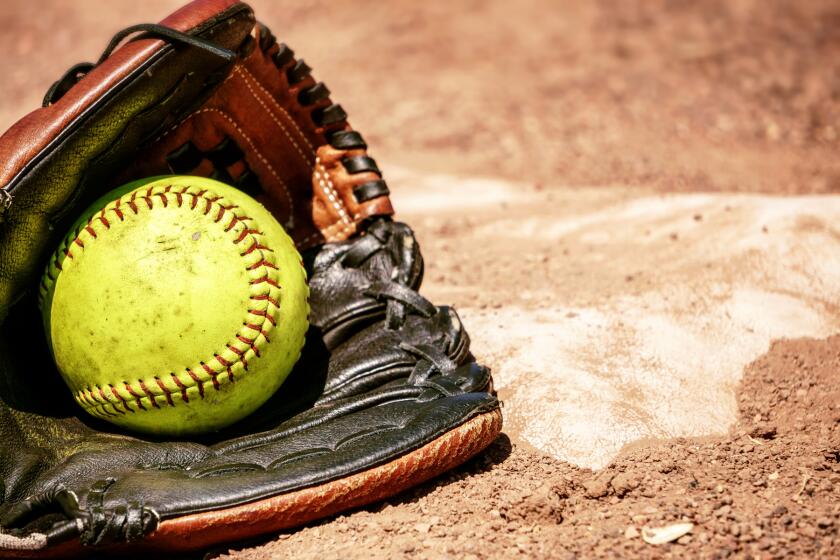Fan of the house: Give him that old-time boxing

At the Hollywood Athletic Club, we got a whiff of what boxing once was, in an artisanal re-creation of a golden era full of flappers and barbershop quartets.
- Share via
Boxing was our first sport, and will probably be our last. Humans are an easily provoked species. Wars — not love-ins — are the milestones on which we plot our purported evolution. Look at Congress, that bunch of brawlers. Now look away (while you still have both retinas).
But don’t look away from boxing too soon. It comes too naturally to us, is too visceral, too much a part of human reflex. Boxing will die only when there is only one of us left. Even so, the last person standing will be found sparring in the moonlight, jabbing at shadows.
Boxing continues to live in gyms, clubs and arenas across the Southland, adopted by thousands of youngsters following in the footsteps of their fathers and their fathers before them. They are trained by descendants of Jack Johnson, or by nobodies who sell used Camrys during the day and had ring dreams at night. The other evening at the Hollywood Athletic Club, we got a whiff of what boxing once was, in an artisanal re-creation of a Golden Era full of flappers and barbershop quartets.
They called them the Schlitz Bouts, certainly a corporate contusion, yet one worth noting. For one night, they gave boxing a retro spin, garnished it with dancers, comics, handlebar mustaches and every supple young actress Hollywood could provide (2 million?).
They held the four amateur bouts in the athletic club’s arena, a silky old place with a balcony ringing it like a tiara. Sugar Shane Mosley, a former boxer of the year, was ringside, along with his son, Sugar Junior, who’s turned pro and already collected a couple of knockouts. A Mosley family fetish, KOs (dad notched nearly 40).
Only 23, the kid is taller than the old man and twice as handsome, about half as old. This is how boxing, and most sports, manage to survive — fathers and sons, trading tactics and occasional bloody lips.
“Actually it was my mom who got me into boxing,” Gabriel Avila is explaining before his middleweight victory. “She said, ‘I know you’re out there fighting in the streets anyway, so why don’t you learn to do it right?’’’
“So she sent me down to Expo Park all through high school,” says Avila, 21. “I love the rawness of it ... just you and your opponent.”
So does George Alvarez, the amateur heavyweight who’s all heart. The sad-eyed 28-year-old says he’s trained by a guy who was tutored by Jack Johnson, which is a little like learning politics from Abraham Lincoln. “I’m not a slugger,” Alvarez explains. “He’s taught me fundamentals. It’s hit and not be hit. That’s boxing.”
No, George, boxing is spectacle, scandal, ring girls and fat men choking on last week’s cigar. It’s the oldest game in town, and often seems the most downtrodden. It lost America when it greedily shunned the networks for pay-TV, then split too many ways. WBC. WBA. IBF. WBO. OMG, as the kids say. Boxing soon had more belts than a Goodyear radial.
Before that, every schoolkid could name the pope, the U.S. president, and the heavyweight champion, not necessarily in that order. Once upon a time, everyone remembered where they were when they saw or listened to the Thrilla in Manila.
These Schlitz Bouts debuted in Chicago, moved here for a night, and will soon depart across the nation for glitzy tributes to boxing and a working-class beer that predates the Civil War.
Even if this throwback tour is only temporary, it’s a turbo boost for the sport. Eventually, I could see the Hollywood Athletic Club, former playground of Charlie Chaplin and Clark Gable, hosting these bouts monthly or even weekly. The three-round fights fly by faster than the taxes in your paycheck.
The mostly 20- to 30-year-olds who filled the dance floors and sponged up the beer and booze were genuinely into it. The Gatsby costumes didn’t hurt. This could be a thing. Or maybe I just want it to be a thing.
No, it should be a thing.
Till then, Sugar Shane Mosley, wearing a plaid jacket and a smiling girlfriend, is talking about how he fought Manny Pacquiao not so many moons ago. Little did anyone know at the time, the 2011 bout came four months after Mosley severed his Achilles’ tendon, one of sport’s most notorious injustices, one from which even Kobe Bryant took almost a year to recover.
“I didn’t tell anybody,” Mosley says, his voice rising. “Three months later, I’m sparring with the boot on. I trained with one foot in a boot!
“Boxing,” he explains, “is all feet and legs.”
No, Champ, boxing is all spectacle and heart. And, like the Mosley family, it’s not done yet.
Follow Chris Erskine on Twitter @erskinetimes
More to Read
Go beyond the scoreboard
Get the latest on L.A.'s teams in the daily Sports Report newsletter.
You may occasionally receive promotional content from the Los Angeles Times.











